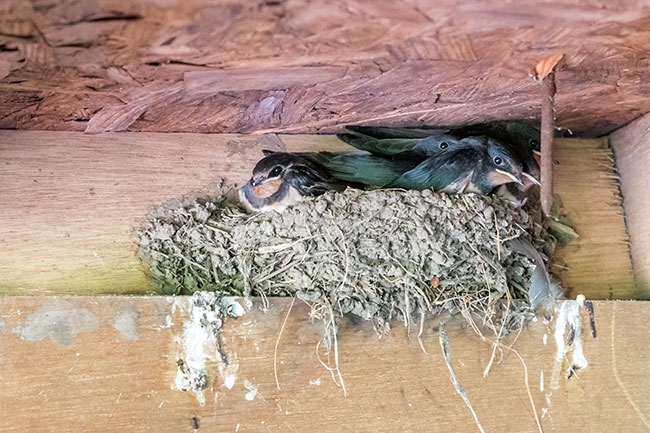
Pest Control: The bird problem
By Alice Sinia
Features Barn Management Migration Matters ProductionIt may seem ironic, but even poultry facilities need a bird control plan. With bountiful food (including bird feed) on the property, wild birds can easily become a disease threat without proper control methods in place.
 Bird nesting could block drains or gutters, creating excessive standing water that causes the roof to collapse. Photo: Adobe Stock
Bird nesting could block drains or gutters, creating excessive standing water that causes the roof to collapse. Photo: Adobe StockIt may seem ironic, but even poultry facilities need a bird control plan. With bountiful food (including bird feed) on the property, pest birds like pigeons, starlings and sparrows can easily become an issue if proper control methods are not taken.
From property damage to health risks, birds can stir up a lot of trouble. One of the most intelligent pests that pest control specialists encounter, birds can both adapt to and fight back against many traditional control methods.
Property damage
Each year, birds cause tens of millions of dollars of damage to machinery, cars, roofs and ventilation systems, according to the International Association of Certified Home Inspectors.
Bird droppings contain acid and can corrode many types of building materials, clog gutters, discolor paint, ruin cloth awnings or even short out electrical equipment.
These damages can be expensive to repair and, in some cases, can even start a fire or lead to moisture damage in the building if left unattended. In a worst-case scenario, bird nesting could block drains or gutters, creating excessive standing water that causes the roof to collapse.
While larger birds can be easily discouraged from claiming a building as their home, small birds like sparrows and swallows can be more difficult to deter. These birds require a more proactive approach and, in some cases, may even qualify as protected species in the area.
Health risks
Birds can threaten the health of employees, customers and guests as they can carry more than 60 diseases and spread micro-organisms that cause lung disease, toxoplasmosis and bird flu.
According to the World Health Organization, birds are the principal hosts or amplifying hosts for several viruses that can be spread to humans. Bird feathers can also cause respiratory problems in sensitive individuals and can cause flare-ups in allergies.
In addition to causing illness, birds carry bird mites, which are parasites that are too small to be seen by the naked eye. Bird mites can jump from an infested bird or bird habitat onto a human, and the bites can cause small red bumps, intense itching, lesions and a crawling sensation on the body.
Bird droppings also can pose serious liability if left unaddressed as they can lead to dangerous accidents, such as slipping and falling. When removing bird droppings, make sure your staff is aware of the possible health risks and equip your team members with knowledge on the most effective ways to clean up the area.
Four stages of attachment
If you have pest birds on your property, it’s important to know how attached they have become. Depending on their level of attachment, pest birds are increasingly difficult to remove. There are four stages of attachment birds pass through that lead to their decision to nest in a specific area:
- Socializing. In this stage, birds simply gather to rest and communicate amongst one another. While flock sizes vary among bird species, any number of unwelcome birds can quickly become a nuisance to a business or work facility.
- Feeding. If nuisance birds think they can find a free meal on your property, they are likely to swoop in and claim their territory. Keeping the area clean of debris and making sure trash cans and recycling bins are covered and emptied on a regular basis can discourage birds from flying in when they are searching for their next meal. Make sure to remind employees and guests to keep outdoor areas clean and to never feed birds close by.
- Roosting. Many pest birds prefer to roost on flat surfaces and roof ledges. When birds reach this stage of attachment, they have found shelter and are regularly spending the night on your property. Inspecting rooftops and clearing standing water following a rain shower is a great start to prevent birds from turning your facility into their next home.
- Nesting. When birds decide to settle down, they will build their nests and start reproducing. In this nesting stage, birds have made the property their permanent home and do not plan on leaving in the near future. At this point, many traditional control methods could become ineffective and additional assistance may be necessary to remove the birds.
Moving forward
Managing a bird infestation is a multi-step process that begins with an inspection. Working with a pest management professional to look for feeding, roosting and loitering areas is essential to identifying and monitoring problem species around your facility. Once you’ve identified the source of the problem, you can work with a professional to install repellants, arrange for relocation or implement exclusion techniques.
Controlling natural and wild bird populations can be difficult, and it’s important that birds aren’t harmed during the process. For the most effective bird control, you should take a proactive approach and assess your property for potential hot spots and weak points before there is a problem. If you notice birds on your property, the best strategy is to contact your pest management provider to explore solutions that shoo birds away before nesting begins.
Alice Sinia is quality assurance manager – regulatory/lab services for Orkin Canada. She focuses on government regulations pertaining to the pest control industry. For more information, visit www.orkincanada.com.
Print this page